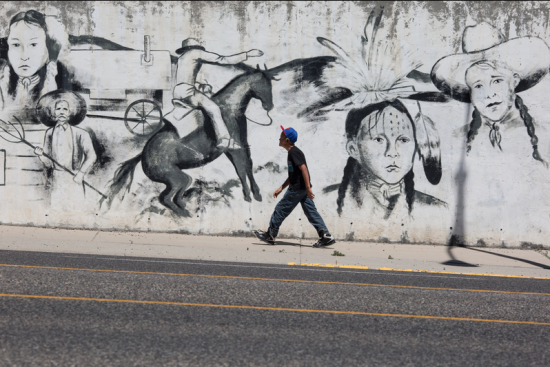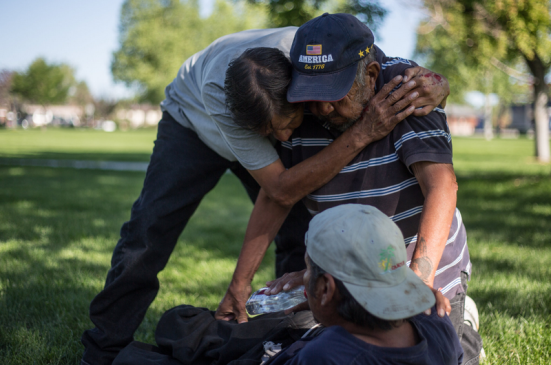
Angeline Vargas, right, comforted her brother James Goggles at a hospital in Casper, Wyo., last week. Mr. Goggles was shot at an alcohol detox facility in Riverton, Wyo. CreditRyan Dorgan for The New York Times
RIVERTON, Wyo. — Roy Clyde was sick of the homeless people who linger in this city’s parks, urinating in public and drinking bottles of vodka and mouthwash, he told the police. So on a recent afternoon, the police say, he grabbed his handgun, walked into an alcohol detox facility called the Center of Hope and shot two men as they lay on green floor mats, killing one and critically wounding the other.
Local officials called it a senseless attack on society’s most vulnerable fringe. But Mr. Clyde, a city parks worker, was white, and the victims were American Indians, members of the Northern Arapaho Tribe. Tribal officials here on the edge of the two-million-acre Wind River Reservation saw the shooting as a hate crime that added another page to a long history of violence and mistrust here in Indian Country.
“There’s a lot of animosity toward the Indian people,” said Dean Goggles, the chairman of the Northern Arapaho Tribal Business Council. “It’s always been there.”

After the shooting, Ron Clyde unloaded his gun, took off his shirt and walked outside, arms raised in surrender, to wait for the police to come, the police said.CreditTibby Mcdowell/The Ranger, via Associated Press
Local news forums discussing the case have swelled with condolences and calls for understanding, but also with accusations of bigotry and “race baiting” by people listing off crimes committed against, or by, American Indians in the area. The police and local leaders held a meeting last weekend to reach out to the homeless in the parks, but some residents said they thought the crime had only accentuated the divisions that can feel as constant as Wyoming winds.
“It should’ve brought people together,” said Cynthia Salazar, who was sitting with her family in a park one recent afternoon. “All I’ve seen are people on both sides. It’s not good.”
Tribal officials have asked federal prosecutors to investigate the shooting as a bias attack. (Wyoming has resisted years of efforts to pass state-level hate-crime laws.)
Had the two men been white, tribal officials say, James Goggles, 50, a cousin of Dean Goggles, would not be lying in a hospital bed, and Stallone Trosper, 29, would not be dead.
Mr. Clyde told the police he had gone looking for “park rangers” — a local slur that tribal officials say refers to homeless Indians. Many of the people who drink in the parks are Native Americans, as are about 85 percent of the detox facility’s clients, according to local officials.

The room where Roy Clyde shot Mr. Goggles and Mr. Trosper as they lay on green floor mats at the Center of Hope. Ryan Dorgan for The New York Times
But an arrest affidavit played down any racial motivation, saying that Mr. Clyde was “targeting transient people regardless of race.” Mr. Clyde, who is being held in the Fremont County jail, has not entered a plea, and his family members did not return phone calls or online messages.
Over decades, even as tribal members and nonmembers became neighbors and intermarried, the legal and cultural borders between them have defined struggles over environmental rules and property rights, crime and justice, and even the town itself.
Riverton was carved out of the Wind River Reservation for white settlement in 1905, becoming a city apart where alcohol is sold and 80 percent of its 10,000 residents are white. Tribal and nontribal residents eat at the same restaurants, are married into one another’s families and play video slots side by side at Wind River Casino. But middle-age Arapaho leaders who grew up on the reservation, population 10,000, have childhood memories of “No Indians” signs in store windows.
Tribal leaders said the shooting was the latest entry in a troubling ledger. They pointed to the case of a gay Northern Arapaho member who was beaten to death by two teenagers in 2013 in what his mother later called a hate crime; and to the case of a Northern Arapaho woman complaining of a pain in her head who said she was turned away from a hospital after staff members there failed to observe that she had been shot. In 2010, tribal members won a voter-discrimination lawsuit against the county’s elections system.

Riverton was carved out of the Wind River Reservation for white settlement in 1905, becoming a city apart where 80 percent of its 10,000 residents are white. Ryan Dorgan for The New York Times
In his ruling on the voting case, Judge Alan B. Johnson of Federal District Court wrote that “discrimination is ongoing, and that the effects of historical discrimination remain palpable.”
Days after the shooting, Northern Arapaho leaders met with elected leaders and law enforcement officials from the area to talk about what to do next. Richard Brannan, a tribal council member, said it seemed as if most of the non-Native American officials did not see the discrimination that the Indian leaders felt so viscerally. Tribal leaders and the Riverton mayor, Lars Baker, met to try to find common ground. But Mr. Baker said he was not sure what “common ground” really meant.
The shooting happened in what city officials and nonprofit workers described as a cinder block sanctuary for people struggling with alcohol and drug problems. James Goggles, “Sonny” to his friends and family, was a Navy veteran. Mr. Trosper was shy and kind, said his uncle George Abeyta, and was hoping to start community college to study political science.
“He wanted to get back on his feet,” Mr. Abeyta said. “He wanted to dry out.”
Mr. Clyde, the man charged with shooting them, had worked for the city’s parks department for about 13 years, mowing lawns and keeping things tidy, said Riverton’s police chief, Mike Broadhead. About a week before the shooting, friends of Mr. Clyde noticed a change in him that coincided with a tense run-in between a female parks employee and one of the “park rangers.”
After the shooting, Mr. Clyde unloaded his gun, took off his shirt and walked outside, arms raised in surrender, to wait for the police to come, the police said.
“It’s like he’s just a guy on a mission,” Chief Broadhead said. “It was like, mission accomplished.”
Mr. Trosper’s uncle said the family sat in teepees with his body, offering prayers and hopes for his safe passage, before burying him last week. Mr. Goggles’s relatives are still cycling through his room at a hospital in Casper. He can barely speak, may be blind in one eye and may not walk again, relatives said.

Ben Piper, left, hugged Teddy Goggles, grandfather of the injured James Goggles, at a park in Riverton, Wyo. Many of the people who drink in the parks are Native Americans, according to local officials. Ryan Dorgan for The New York Times
The residue of the shooting has also stretched across Riverton and back to the park where a cluster of people — some family, some friends — were drinking in the shade. They had started with mouthwash that morning, but by 3 p.m. had moved on to a plastic quart bottle of vodka.
“We’re all park rangers right here,” said Vincent Lee Yellow Bear, whose two grown children shared shots with him. The conversation wandered: They had known Mr. Goggles — a good guy. They were not homeless, they just did not want to go to their homes. They were angry about the shooting, but said it would not displace them.
“My family will always be here,” Mr. Yellow Bear said. “We ain’t scared here.”
Source: http://nyti.ms/1KA5Xgs



Alcoholism is a disease no matter what your national origin is, and it comes in all shapes and sizes, it does not discriminate. And it is a fact that Native people never indulged in alcohol until it was introduced to them by Europeans. What has happened in this particular incident is unfortunate, and heart wrenching. In this article it states that at one time there were signs in local businesses that said “NO INDIANS”, to me that sounds a lot like what was done in the south before the Civil Right movement. I ask myself many times why are my people still discriminated against in 2015, 50 years after the Civil Rights Movement. I can only come up with one answer, the Civil Rights Movement had nothing to do with Native people, and in this country it is still alright to treat Native people with no regard of human decency.
LikeLike
Reblogged this on redtankgirl5.
LikeLike